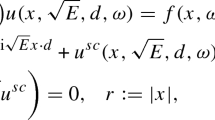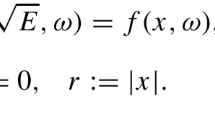Abstract
We study an inverse problem for the two-dimensional random Schrödinger equation (Δ + q + k 2)u = 0. The potential q(x) is assumed to be a Gaussian random function whose covariance operator is a classical pseudodifferential operator. We show that the backscattered field, obtained from a single realization of the random potential q, determines uniquely the principal symbol of the covariance operator of q. The analysis is carried out by combining harmonic and microlocal analysis with stochastic methods.
Similar content being viewed by others
References
Abramowitz, M., Stegun, I.: Tables of Mathematical Functions. 9th print, New York: Dover, 1970
Adler R. (1981). The Geometry of Random Fields. John Wiley & Sons, New York
Agmond S. (1975). Spectral properties of Schrödinger operators and scattering theory. Ann. Scuola norm. Sup. Pisa (4) 2: 151–218
Agranovsky M. and Quinto E. (1996). Injectivity sets for the Radon transform over circles and complete systems of radial functions. J. Funct. Anal. 139: 383–414
Astala K. and Päivärinta L. (2006). Uniqueness in Calderon’s inverse conductivity problem in the plane. Ann. Math. 163: 265–299
Bal G., Papanicolaou G. and Ryzhik L. (2002). Radiative transport limit for the random Schrödinger equation. Nonlinearity 15: 513–529
Birman M.Sh. and Krein M.G. (1962). On the theory of wave operators and scattering operators. (Russian) Dokl. Akad. Nauk SSSR 144: 475–478
Bogachev, V.: Gaussian measures. Mathematical Surveys and Monographs, 62. Providence, RI: Amer. Math. Soc., 1998
Borcea L., Papanicolaou G., Tsogka C. and Berryman J. (2002). Imaging and time reversal in random media. Inverse Problems 18: 1247–1279
Bourgain J. and Kenig C.E. (2005). On localization in the continuous Andersson-Bernoulli model in higher dimension. Invent. Math. 161: 389–426
Brown R. and Uhlmann G. (1997). Uniqueness in the inverse conductivity problem for nonsmooth conductivities in two dimensions. Commun. Part. Diff. Eqs. 22(5–6): 1009–1027
Calderón, A.-P.: On an inverse boundary value problem. Seminar on Numerical Analysis and its Applications to Continuum Physics (Rio de Janeiro, 1980), Rio de Janeiro: Soc. Brasil. Mat., 1980, pp. 65–73
Colton D. and Kress R. (1983). Integral Equation Methods in Scattering Theory. Pure and Applied Mathematics. John Wiley & Sons, New York
Cramer H. and Leadbetter M. (1967). Stationary and Related Stochastic Processes. John Wiley & Sons, New York
Eskin G. and Ralston J. (1989). The inverse backscattering problem in three dimensions. Commun. Math. Phys. 124: 169–215
Eskin G. and Ralston J. (1991). Inverse backscattering in two dimensions. Commun. Math. Phys. 138: 451–486
Fischer W., Leschke H. and Müller P. (2000). Spectral localization by Gaussian random potentials in multi-dimensional continuous space. J. Stat. Phys. 101: 935–985
Fröhlich J. and Spencer T. (1983). Absence of diffusion in the Anderson tight binding model for large disorder or low energy. Commun. Math. Phys. 88(2): 151–184
Gel’fand I. and Vilenkin N. (1964). Generalized Functions. Vol. 1-4.. Academic Press, London-New York
Greenleaf A., Lassas M. and Uhlmann G. (2003). The Calderon problem for conormal potentials, I: Global uniqueness and reconstruction. Comm. Pure Appl. Math. 56: 328–352
Glimm J. and Jaffe A. (1971). The Yukawa quantum field theory without cutoffs. J. Funct. Anal. 7: 323–357
Hähner P. (1996). A periodic Faddeev-type solution operator. J. Differ. Eqs. 128(1): 300–308
Hörmander L. (1985). The Analysis of Linear Partial Differential Operators. Vol. I.. Springer-Verlag, Berlin
Hörmander L. (1985). The Analysis of Linear Partial Differential Operators. Vol. III.. Springer-Verlag, Berlin
Jerison D. and Kenig K. (1985). Unique continuation and absence of positive eigenvalues for Schrödinger operators. Ann. Math. 121: 463–494
Kahane J.-P. (1985). Some Random Series of Functions.. Cambridge Univ. Press, Cambridge
Kenig C., Ruiz A. and Sogge C. (1987). Uniform Sobolev Inequalities and Unique continuation for second order constant coefficients differential operators. Duke Math. J. 55: 329–347
Koch H. and Tataru D. (2001). Carleman estimates and unique continuation for second order elliptic equations with nonsmooth coefficients. Commun. Math. Pure Appl. 54: 339–360
Kotani, S.: Lyapunov exponents and spectra for one-dimensional random Schrödinger operators. Random Matrices and Their Applications (Brunswick, Maine, 1984), Contemp. Math. 50, Providence, RI: Amer. Math. Soc., 1986, pp. 277–286
Kotani S. and Simon B. (1987). Localization in general one-dimensional random systems. II. Continuum Schrödinger operators. Commun. Math. Phys. 112: 103–119
Lassas, M., Päivärinta, L., Saksman, E.: Inverse problem for a random potential. In: Partial Differential Equations and Inverse Problemsx, Contemp. Math. 362 Providence, RI: Amer. Math. Soc., 2004, pp. 277–288
Ledoux M. and Talagrand M. (1991). Probability in Banach Spaces. Springer, Berlin-Heidelberg-New York
Lehtinen M., Päivärinta L. and Somersalo E. (1989). Linear inverse problems for generalised random variables. Inverse Problems 5: 599–612
Nachman A. (1988). Reconstructions from boundary measurements. Ann. Math. 128: 531–576
Nachman A. (1996). Global uniqueness for a two-dimensional inverse boundary value problem. Ann. Math. (2) 143(1): 71–96
Nachman A. and Sylvester, J., Uhlmann G. (1988). An n-dimensional Borg-Levinson theorem. Commun. Math. Phys. 115(4): 595–605
Neimam-Zade M. and Shkalikov A. (1999). The Schrödinger operators with singular potentials from the multiplicator’s spaces. (Russian) Matem. Zametki 66: 723–733
Ola P., Päivärinta L. and Serov V. (2001). Recovering singularities from backscattering in two dimensions. Comm. Partial Differ. Eqs. 26: 697–715
Päivärinta, L.: Analytic methods for inverse scattering theory. In: New Analytic and Geometric Methods in Inverse Problems. Springer Lecture Notes Ed. Bingham, K., Kurylev, Y., Somersalo, E., Berline-Heidelberg New York: Springer, 2003, pp. 165–185
Päivärinta L., Panchenko A. and Uhlmann G. (2003). Complex geometrical optics solutions for Lipschitz conductivities. Rev. Mat. Iberoamericana 19: 57–72
Päivärinta L. and Serov V. (2002). An n-dimensional Borg-Levinson theorem for singular potentials. Adv. in Appl. Math. 29(4): 509–520
Päivärinta, L., Somersalo, E. (eds.): Inverse Problems in Mathematical Physics. Lecture Notes in Physics, 422. Berlin: Springer-Verlag, 1993
Papanicolaou G., Postel M. and White B. (1991). Frequency content of randomly scattered signals. Siam Review 33: 519–626
Papanicolaou G. and Weinryb S. (1994). A functional limit theorem for waves reflected by a random medium. Appl. Math. Optim. 30: 307–334
Pastur L. (1980). Spectral properties of disordered systems in the one-body approximation. Commun. Math. Phys. 75: 179–196
Peetre J. (1960). Rectification à l’article Une charactérization abstraite des opérateurs differentiels. Math. Scand. 8: 116–120
Rozanov Y. (1982). Markov Random Fields. Applications of Mathematics. Springer-Verlag, Berlin-Heidelberg-New York
Simon B. (1985). Localization in general one-dimensional random systems. I. Jacobi matrices. Commun. Math. Phys. 102: 327–336
Simon B. and Wolff T. (1986). Singular continuous spectrum under rank one perturbations and localization for random Hamiltonians. Comm. Pure Appl. Math. 39(1): 75–90
Stefanov P. (1992). Generic uniqueness for two inverse problems in potential scattering. Comm. Partial Differ. Eqs. 17: 55–68
Stein E.M. (1993). Harmonic Analysis. Princeton University Press, Princeton, NJ
Sylvester J. and Uhlmann G. (1987). A global uniqueness theorem for an inverse boundary value problem. Ann. Math. 125(1): 153–169
Taylor, M. E.: Tools for PDE. Pseudodifferential Operators, Paradifferential Operators, and Layer Potentials. Mathematical Surveys and Monographs 81, Providence, RI: Amer. Math. Soc., 2000
Ueki N. (2004). Wegner estimates and localization for Gaussian random potentials. Publ. Res. Inst. Math. Sci. 40(1): 29–90
Uhlmann, G.: Inverse boundary value problems for partial differential equations. Proceedings of the ICM. Vol. III (Berlin, 1998). Doc. Math. J. DMV Extra Vol. III, pp. 77–86 (1998)
Author information
Authors and Affiliations
Corresponding author
Additional information
Communicated by B. Simon.
Rights and permissions
About this article
Cite this article
Lassas, M., Päivärinta, L. & Saksman, E. Inverse Scattering Problem for a Two Dimensional Random Potential. Commun. Math. Phys. 279, 669–703 (2008). https://doi.org/10.1007/s00220-008-0416-6
Received:
Accepted:
Published:
Issue Date:
DOI: https://doi.org/10.1007/s00220-008-0416-6




